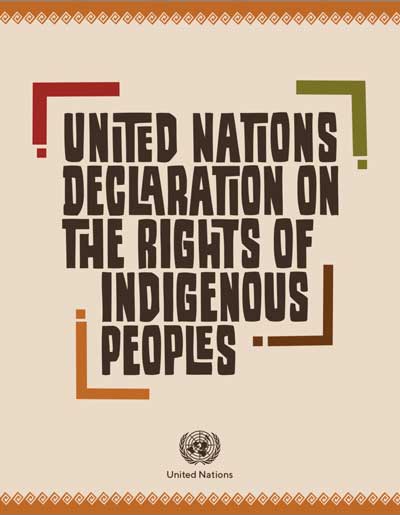Indigenous peoples are equal to all other peoples, while recognizing the right of all peoples to be different, to consider themselves different, and to be respected as such […] all peoples contribute to the diversity and richness of civilizations and cultures, which constitute the common heritage of hu- mankind […] all doctrines, policies and practices based on or advocating superiority of peoples or individuals on the basis of national origin or racial, religious, ethnic or cultural differences are racist, scientifically false, legally invalid, morally condemnable and socially unjust, Reaffirming that indigenous peoples, in the exercise of their rights, should be free from discrimination of any kind. – United Nations Declaration on the Rights of Indigenous Peoples | Access the full document here >>
Alternative download link on this website (PDF, 154 KB) >>
Source: United Nations Declaration on the Rights of Indigenous Peoples
URL: https://www.un.org/development/desa/indigenouspeoples/wp-content/uploads/sites/19/2018/11/UNDRIP_E_web.pdf
Accessed: 30 May 2019
The Universal Declaration of Human Rights empowers us all. The principles enshrined in the Declaration are as relevant today as they were in 1948. […] We can take action in our own daily lives, to uphold the rights that protect us all and thereby promote the kinship of all human beings.
Source: United Nations manifesto on the purpose of celebrating “Human Rights Day” each year on 10 December
URL: https://www.un.org/en/events/humanrightsday/
Date visited: 25 July 2020
At the heart of all the violations of our human rights has been the failure to respect our integrity, and the insistence on speaking for us, defining our needs and controlling our lives.
Source: Karbi leader Dharamsing Teron quoted by Meenaxi Barkataki-Ruscheweyh in Performing Ethnicity to Resist Marginalisation: The Tangsa in Assam (PhD thesis. Amsterdam: Vrije Universiteit, 2015)
URL: http://www.worldcat.org/oclc/1039320680
Date visited: 25 July 2020
Tips for using interactive maps
Toggle to normal view (from reader view) should the interactive map not be displayed by your tablet, smartphone or pc browser
For details and hyperlinks click on the rectangular button (left on the map’s header)
Scroll and click on one of the markers for information of special interest
Explore India’s tribal cultural heritage with the help of another interactive map >>
See also
Adverse inclusion | Casteism | Rural poverty
Demographic Status of Scheduled Tribe Population of India (Census figures 2011)
Fact checking | Figures, census and other statistics
Human Rights Commission (posts) | www.nhrc.nic.in (Government of India)
Search tips | Names of tribal communities, regions and states of India
“What is the Forest Rights Act about?” – Campaign for Survival and Dignity
“Who are Scheduled Tribes?” – Government of India (National Commission for Scheduled Tribes, NCST)

Tribal Literature by G.N. Devy >>
Free eBooks & Magazine: Adivasi literature and languages >>
“India, a union of states, is a Sovereign, Secular, Democratic Republic with a Parliamentary system of Government. The President is the constitutional head of Executive of the Union. In the states, the Governor, as the representative of the President, is the head of Executive. The system of government in states closely resembles that of the Union. There are 28 states and 8 Union territories in the country. Union Territories are administered by the President through an Administrator appointed by him/her. From the largest to the smallest, each State/UT of India has a unique demography, history and culture, dress, festivals, language etc. This section introduces you to the various States/UTs in the Country and urges you to explore their magnificent uniqueness…” – KnowIndia (Government), States and Union Territories (Visited: 2 September 2023)
Learn more about India’s 28 States and 8 Union Territories – From Andhra Pradesh to West Bengal | Nutrition >>
